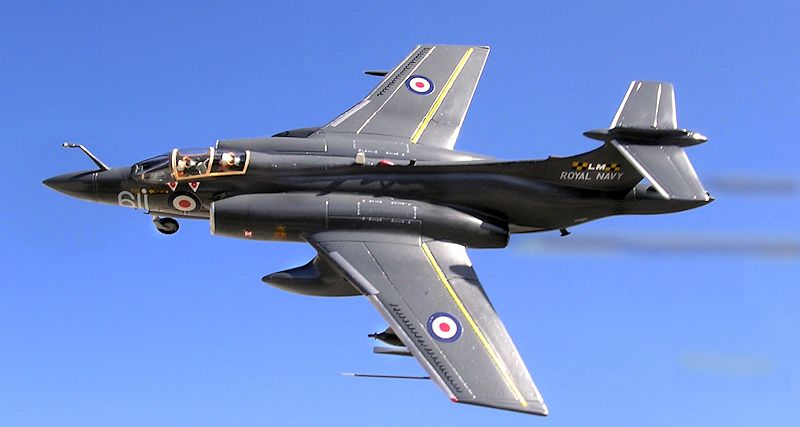
Matchbox 1/72 Buccaneer S.2
| KIT #: | PK- |
| PRICE: | 3 Euros when new |
| DECALS: | Two options |
| REVIEWER: | Carmel J. Attard |
| NOTES: |

| HISTORY |
The development of the Buccaneer S2
goes back as early as 1959. Blackburn Company was examining alternative engines
to the Gyron Junior.
The Gyron Junior was also developed offering
substantially increased thrust. Most promising at the time was Rolls-Royce RB163
Spey turbofan that was committed in its civil form for the De Havilland Trident
airliner. Adopting the RB163 Spey for the Buccaneer required changes to both air
intake and jet pipe. These design changes were refined during 1960 by
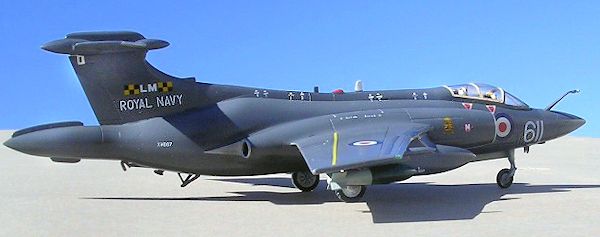 which stage
the Spey Mk 101 had been effectively selected for the Mk 2 Buccaneer.
which stage
the Spey Mk 101 had been effectively selected for the Mk 2 Buccaneer.
The first
prototype Buccaneer flew in mid 1963. Ever since its maiden flight it went
through many development tests and trials. Buccaneer XK400 took part in handling
and hot weather trials, the latter being conducted in Malta. The aircraft was
designed for low level strike and had an immensely strong structure, used the
most sophisticated aerodynamic shape with an area rule design technique to give
smooth transonic characteristics. Low take off and landing speeds are achieved
by the use of boundary layer control, air being taken from the engines and blown
through the slots in the leading edge of the wing and tail plane, flaps and
ailerons to give increased lift. Clamshell type dive brakes are fitted at rear
of fuselage. The Buccaneer has four under wing pylon attachment points enabling
a wide variety of strike weapons to be carried. Bombs could also be carried into
an internal weapons bay.
The HS Buccaneer entered service with
the Royal Navy in 1965 and Buccaneers of both marks were a common sight in the
two Malta airfields namely Luqa and Hal Far. They carried interesting tail
markings. When embarked, visiting Buccaneers of 801 Squadron carried HMS
Victorious tail code ’V’, HMS Ark
 Royal ‘R’,
Eagle ’E’, Hermes ‘H’, and Victorious ’V’ with Centaur ‘C’ in reserve plus
carriers Albion ‘A’ and Bulwark ‘B’. Other Buccaneers that visited Luqa were
those namely of No 12 Squadron RAF. These took part in bi-weekly routine
exercises alongside Lightning fighters, Vulcan bombers, Victor tankers and
Hercules C-130 support aircraft. Crew from both Buccaneer and Lightning
squadrons also attended society meetings organised by the Malta Aircraft
Enthusiasts at the premises in Floriana, where they were entertained and on
their side were bombarded with all sort of interesting questions by the society
members.
Royal ‘R’,
Eagle ’E’, Hermes ‘H’, and Victorious ’V’ with Centaur ‘C’ in reserve plus
carriers Albion ‘A’ and Bulwark ‘B’. Other Buccaneers that visited Luqa were
those namely of No 12 Squadron RAF. These took part in bi-weekly routine
exercises alongside Lightning fighters, Vulcan bombers, Victor tankers and
Hercules C-130 support aircraft. Crew from both Buccaneer and Lightning
squadrons also attended society meetings organised by the Malta Aircraft
Enthusiasts at the premises in Floriana, where they were entertained and on
their side were bombarded with all sort of interesting questions by the society
members.
Buccaneer S2 featured in the kit
markings represents XV867/611 when attached to 803 Squadron. 803 squadron was
the 5th and final Fleet Air Arm’s
Buccaneer Mk2 Squadron, which was formed on 3rd
July 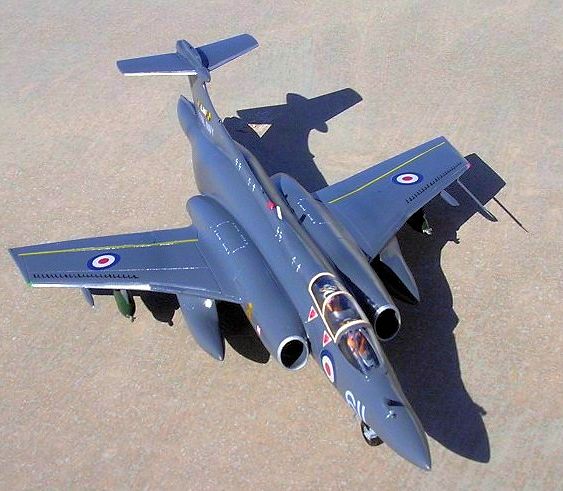 1967
at Lossiemouth, UK. This was the Buccaneer Headquarters Squadron. 803 had no
assigned air group and its aircraft carried the Lssiemouth ‘LM’ tail codes. Its
purpose was to carry out weapons trials and various testing, of which role its
aircraft were engaged throughout the Squadron’s short existence.
1967
at Lossiemouth, UK. This was the Buccaneer Headquarters Squadron. 803 had no
assigned air group and its aircraft carried the Lssiemouth ‘LM’ tail codes. Its
purpose was to carry out weapons trials and various testing, of which role its
aircraft were engaged throughout the Squadron’s short existence.
Initially the
squadron had 4 pilots and 2 observers, plus a weapons system engineer. It
undertook trials on the Buccaneer’s weapons system and developed attack modes.
At one point during the service life of the squadron it did fly on to HMS Hermes
in the Indian Ocean in August 1968. During that period 4 aircraft departed
Lossiemouth in the company of two Victor tankers and completing the deployment
in less than 18 flying hours and 4 days. The demonstration of rapid deployment,
which took part of Exercise Bobbin Plus, was perhaps the high point of No 803’s
period with Buccaneer.
| THE KIT |
Moulded in 2-color plastic the kit
comprises of 40 parts with engraved panel lines of somewhat coarse nature. There
is one clear part, which is the cockpit canopy. The cockpit consists essentially
of moulded on side consoles, two ejection seats and two crew figures. Instrument
panel, internal wind screen and rear coming need to add. Most parts lack the
detail we are used to with today’s standard of
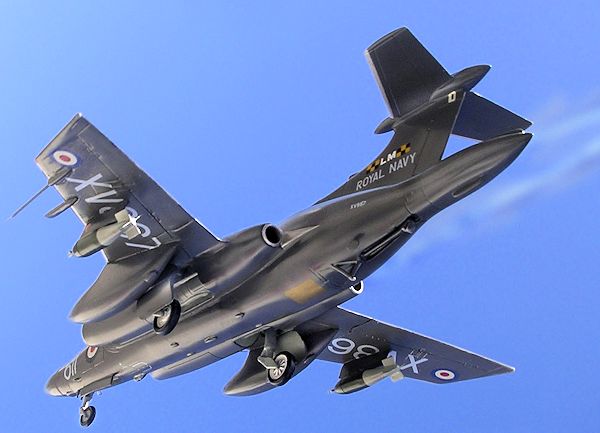 kits. Main
undercarriage comes in three items each while the nose gear is moulded in one
piece. The rear engine exhaust comes separate, as also are the air intake
fronts, which reveal jet rotor front, which are separate part items. Wheel well
detail is minimal and a little additional extra detail added will improve their
appearance. No wing pylons, stores and wing tanks are provided rendering the kit
as being very basic. The kit has a bulging bomb bay as adopted by the type on
some of the RAF Buccaneers. The kit provides for two RAF machines options
with 15 and 16 Squadron,
these both being in standard dark sea grey and dark green upper surfaces and
light aircraft grey lower surfaces.
kits. Main
undercarriage comes in three items each while the nose gear is moulded in one
piece. The rear engine exhaust comes separate, as also are the air intake
fronts, which reveal jet rotor front, which are separate part items. Wheel well
detail is minimal and a little additional extra detail added will improve their
appearance. No wing pylons, stores and wing tanks are provided rendering the kit
as being very basic. The kit has a bulging bomb bay as adopted by the type on
some of the RAF Buccaneers. The kit provides for two RAF machines options
with 15 and 16 Squadron,
these both being in standard dark sea grey and dark green upper surfaces and
light aircraft grey lower surfaces.
| CONSTRUCTION |
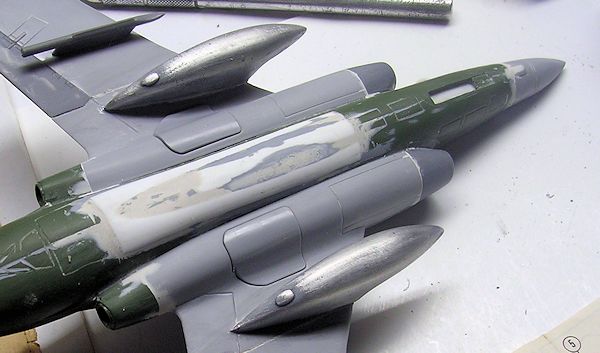 I then
followed the kit instructions adding detail to the cockpit interior as well as
external detail as I went along. My aim was to produce a Royal Navy Buccaneer S2
that I picked from Xtradecal sheet XO14-72. In fact the one I chose to do was
XV867/611 of 803 Squadron RN circa 1969. The type was based at the Navy land
base HMS Fulmar in Lossiemouth, UK.
I then
followed the kit instructions adding detail to the cockpit interior as well as
external detail as I went along. My aim was to produce a Royal Navy Buccaneer S2
that I picked from Xtradecal sheet XO14-72. In fact the one I chose to do was
XV867/611 of 803 Squadron RN circa 1969. The type was based at the Navy land
base HMS Fulmar in Lossiemouth, UK.
After replacing the bomb bay with a
level one bent in shape to conform with the rest of fuselage,
the nose wheel well which was blank, was sawn open and a
box like bay was made from plastic card to bring the deep bay complete with a
floor. The exhaust outlets were drilled open and a couple of tube or pipes
added. These were blanked at front end. Lead weight was added to the nose cone
area. I cast two wing tanks in aluminium which were copies of wing tanks found
in the Airfix kit
(perhaps one of these days,
Carmel will share with us how these can be done at home. Ed).
I added Matra
Martel wing pylons which were spare from a Frog kit of the Buccaneer and which
were then also slightly modified to the shape of pylons that carry 1,000lb bombs
and a single bomb was carried under each wing. A small air intake scoop added
under the fuselage, and several aerials were also antennas added.
| COLORS & MARKINGS |
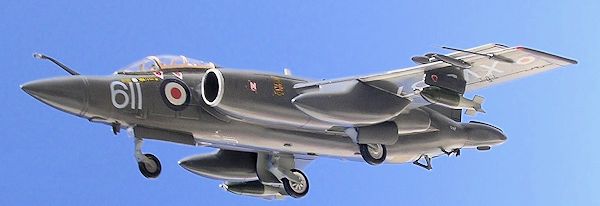 Wheel
wells were white while sliding parts of wheel legs were metal finish. The kit
was overall extra dark sea grey finish BS381C 640 for which I used the Model
Master equivalent. Cockpit canopy was dark grey with touches of light grey,
black and white. An overall coat of Johnson’s Klear was applied followed by
application of decals. Leading edges were metal finish which I did using strips
cut from a silver decal sheet. After application of decals the kit was given an
overall sheen of semi gloss Model Master lacquer.
Wheel
wells were white while sliding parts of wheel legs were metal finish. The kit
was overall extra dark sea grey finish BS381C 640 for which I used the Model
Master equivalent. Cockpit canopy was dark grey with touches of light grey,
black and white. An overall coat of Johnson’s Klear was applied followed by
application of decals. Leading edges were metal finish which I did using strips
cut from a silver decal sheet. After application of decals the kit was given an
overall sheen of semi gloss Model Master lacquer.
| CONCLUSIONS |
This was my third Buccaneer and with
each occasion it proved to be a build different from either of the previous ones
since they were a Navy S1 and a Gulf war RAF S2B. The Buccaneer was an
impressive aircraft type and the mention of the type takes me to the low level
runway beat up across Luqa airfield flying at tree top height, an attack role of
which it was famous for to evade the enemy radar.
| REFERENCES |
REF: Wings of fame. Vol 14.
September 2013
If you would like your product reviewed fairly and fairly quickly, please contact the editor or see other details in the Note to Contributors.